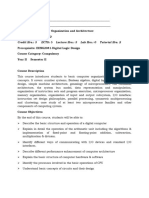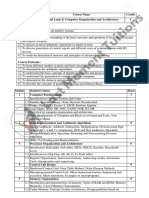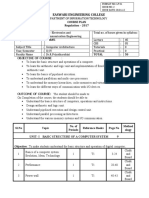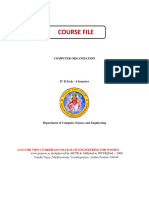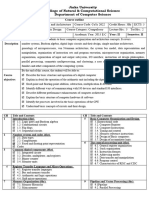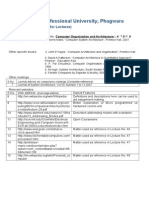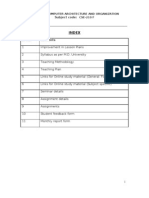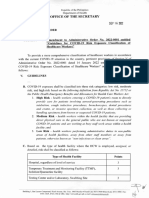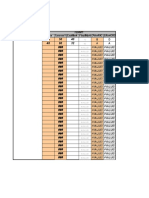Course 21CSS201 Course COMPUTER ORGANIZATION Course S Engineering Sciences L T
Code T Name AND ARCHITECTURE Category
3 0
Pre- Nil Co- Nil Progressive Courses Nil
requisite requisite
Courses Courses
Course Offering Computer Science Data Book / Nil
Department and Engineering Codes/Standards
Course Objectives: The purpose of learning this course is to: Program Learning Outcomes (PLO)
CLR- Understand the Fundamentals of computers, Memory operations 1 2 3 4 5 6 7 8 9 10 11 12 13 14
1 and Addressing Modes
CLR- Know about Functions of Arithmetic and Logic unit
2
CLR- Explore the Operations of Control Unit, Execution of Instruction
3 and Pipelining
CLR- Classify the Need for Parallelism, Multicore and Multiprocessor
4 Systems
Environment & Sustainability
Analysis, Design, Research
CLR- Understand the Concepts and functions of Memory unit, I/O unit
Engineering Knowledge
Individual &Team Work
Design & Development
Project Mgt. & Finance
5
Modern Tool Usage
Life Long Learning
Problem Analysis
Society & Culture
Communication
Course Outcomes (CO): At the end of this course, learners will be able to:
PSO - 1
PSO - 2
Ethics
CO-1 Identify the computer hardware and how software interacts with computer 3 2 - - - - - - - - - - 1 -
hardware
CO-2 Apply Boolean algebra as related to designing computer logic ,through 3 2 - - - - - - - - - - - 2
simple combinational and sequential logic circuits
CO-3 Examine the detailed operation of Basic Processing units and the 3 - - - - - - - - - - - - -
performance of Pipelining
CO-4 Analyze concepts of parallelism and multi-core processors. 3 - - - - - - - - - - - - 2
CO-5 Classify the memory technologies, input-output systems and evaluate the 3 2 - - - - - - - - - - - 3
performance of memory system
Unit 1: Introduction to Number System and Logic Gates: Number Systems- Binary, Decimal, Octal, Hexadecimal; Codes- Grey, BCD,Excess-3, ASCII, Parity;
Binary Arithmetic- Addition, Subtraction, Multiplication, Division using Sign Magnitude,1’s compliment, 2’s compliment, BCD Arithmetic; Logic Gates-AND,
OR, NOT, NAND, NOR, EX-OR, EX-NOR.
Unit 2 : Basic structure of computers: Functional Units of a computer, Operational concepts, Bus structures, Memory addresses and operations, assembly language
, Instructions, Instruction sequencing, Addressing modes. Case study: 8086.
Unit 3: Design of ALU: De Morgan’s Theorem, Adders, Multiplier – Unsigned, Signed, Fast, Carry Save Addition of summands; Division–Restoring and Non-
Restoring; IEEE 754 Floating point numbers and operations.
Unit 4: Control Unit: Basic processing unit, ALU operations, Instruction execution, Branch instruction, Multiple bus organization, Hardwired control, Generation
of control signals, Micro-programmed control; Pipelining: Basic concepts of pipelining, Performance, Hazards-Data, Instruction and Control, Influence on
instruction sets.
Unit 5: Parallelism: Need, types , applications and challenges, Architecture of Parallel Systems-Flynn’s classification; ARM Processor: The thumb instruction set,
Processor and CPU cores, Instruction Encoding format, Memory load and Store instruction, Basics of I/O operations. Case study: ARM 5 and ARM 7
Architecture.
�Learning 1. 5.
CarlHamacher,ZvonkoVranesic,SafwatZaky,ComputerOrganization,5thed.,McG WilliamStallings,ComputerOrganizationandArchitecture–D
Resources raw-Hill,2015 esigningforPerformance,10thed.,Pearson Education,2015
2. 6.
KaiHwang,FayeA.Briggs,ComputerArchitectureandParallelProcessing”,3rded.,
McGrawHill,2016 DavidA.PattersonandJohnL.HennessyComputerOrganizatio
3. GhoshT.K.,ComputerOrganizationandArchitecture,3rded.,TataMcGraw- nandDesign-AHardwaresoftwareinterface,5thed.,Morgan
Hill,2011 Kaufmann,2014
4. P.Hayes,ComputerArchitectureandOrganization,3rded.,McGrawHill,2015.
Continuous Learning Assessment (CLA) By The CoE
- By the Course Faculty
Bloom’s Formative Life Long* Summative
Level of Thinking CLA-I Average of Learning Final
unit test CLA-II- Practice Examination
(50%) (10%) (40% weightage)
Theory Practice Theory Practice Theory Practice
Level 1 Remember 30% - 30% - 30% -
Level 2 Understand 30% - 30% - 30% -
Level 3 Apply 20% - 20% - 20% -
Level 4 Analyze 20% - 20% - 20% -
Level 5 Evaluate - - - - - -
Level 6 Create - - - - - -
Total 100 % 100 % 100 %
Course Designers
Experts from Industry Experts from Higher Technical Institutions Internal Experts
Mr.Saminath Sanjai, Borqs Technologies,Inc. Bengaluru 1.Dr.K.Vijaya, Dr.Anitha D, SRMIST







